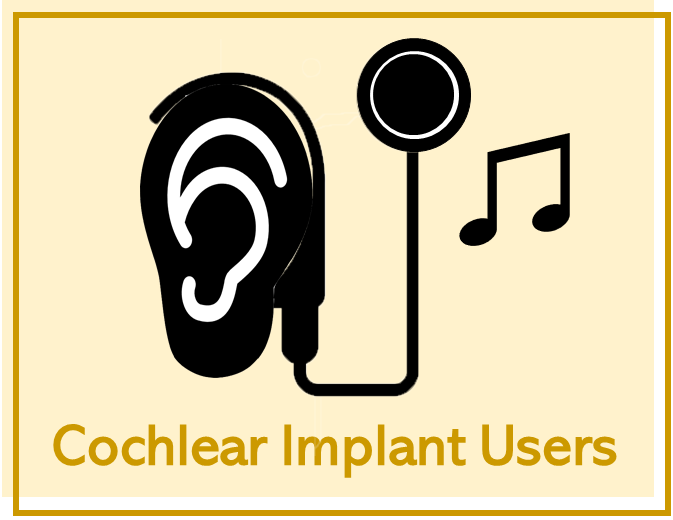See also: Articles on Music, Hearing Loss, and Hearing Devices
Improving Music Perception and Appraisal:
Information for Cochlear Implant (CI) Users and Families



1, 2
Introduction
Music is an important part of many people’s lives. After speech recognition, improving music listening is the second most common desire of CI users (Gfeller, 2001). Unfortunately, hearing loss can reduce music perception and enjoyment. Additionally, longer experience using a cochlear implant (CI) will not automatically improve music perception. Improving music enjoyment usually requires some practice or music training.
Music training involves focused, purposeful listening to musical sounds over weeks or months. Research has shown that systematic training can improve perception and enjoyment of music, which can enhance important aspects of well-being and social life.
Q: Why is music training helpful?
A: There are many reasons music training can improve people’s lives and overall CI experience.
-
Music is a common part of everyday life for many people. It is hard to completely avoid music.
-
Music can be heard in many businesses, restaurants, and at parties.
-
Music is part of many social, spiritual, and cultural events, such as weddings, funerals, and religious events.
-
Many people listen to music to improve their mood or for entertainment.
-
Music can bring back special memories (music from graduation, weddings, etc.).
-
Music can be an important aspect of well-being and social life.
-
-
Improved music perception can enhance aspects such as:
-
quality of life
-
feeling part of everyday social life
-
feeling greater satisfaction with your cochlear implant (CI)
-
-
Listening skills gained from music training may also carry over to some complex speech perception situations, such as listening to speech in noisy places:
-
There are similarities in how the brain processes music and speech (Gfeller et al. 2015). Therefore, improving music listening may also improve speech perception.
-
Listening to music is more challenging than listening to speech and can make your listening skills stronger, just as sit-ups and other exercises make your muscles stronger.
-
Music training can “fine-tune” the brain. This is referred to as neural plasticity, which can help you get the most out of your implant.
-
Q: What does research say about music perception and training for CI users?
A: Some parts of music are more challenging to hear, but perception and enjoyment can improve with training.
-
Most CI users can hear rhythm accurately.
-
Most CI users have some difficulty hearing pitch, melodies and timbre (tone quality) of different instruments.
-
There is a difference between music appreciation and recognition.
-
A person might be able to recognize what instrument they are listening to, but that does not mean it sounds pleasant.
-
The opposite can also happen. A person may not be able to recognize what they are hearing, but they may still enjoy listening to it.
-
-
General results from training:
-
CI users can improve both recognition and enjoyment of timbre (tone quality) and melodies through music training.
-
Improved music enjoyment can improve social integration and quality of life.
-
Some aspects of speech perception are similar to music perception, so improved music perception may carry over to speech perception (Looi, Gfeller, and Driscoll, 2012).
-
Q: Why might people want to use music-specific training as well as speech training alone?
A: Music is different from speech in a variety of ways.
-
Frequency range: Music includes much higher and lower notes (wider frequency range) than speech, so you can improve a wider range of sounds.
-
Processing skills: Music enjoyment requires more subtle listening skills than listening to speech.
-
Design of processing strategies: Cochlear implants have been designed for basic speech sounds. Improving your listening skills through music training can help you get the most out of your CI for more challenging spoken conversation and music enjoyment.
Click here to read more about the complexities of musical elements with CI technology.

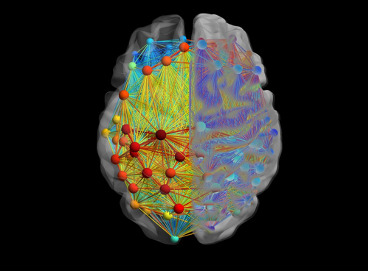
Skills gained from music training may enhance speech perception. Some perceptual skills gained from extended music training can generalize to parts of speech. Through this process, the brain can make new connections through neuroplasticity (i.e. brain plasticity).
-
Brain plasticity involves auditory learning through training and challenging listening experiences. This can promote the development of perceptual skills.
-
Music engages multiple regions in the brain related to attention, memory, motor skills, and emotions; this leads to more neural connections being made.
-
-
OPERA hypothesis: proposes that music training benefits how the brain processes speech. These benefits are driven by plasticity in speech-processing networks when these five conditions are met:
-
Overlap: There is an overlap in brain networks that process similar sounds (for example, pitch, rhythm) in both music and speech.
-
Precision: Music listening involves more fine-tuned listening than speech; this encourages a higher level of mental processing.
-
Emotion: Listening to music that you like can lead to positive emotions. Positive emotions can encourage neural plasticity.
-
Repetition: Music often has a lot of repeated melodies and rhythms. Repetition helps the brain to learn.
-
Attention: Music is often good at catching our attention. Paying close attention leads to better neural connections.
-
-
When conditions of the OPERA hypothesis are met, neural plasticity is improved both for music and speech (Patel, 2011).
A musician and bilateral cochlear implant user Alex Mansouri shares the story of improving music perception.
Strategies and Considerations for Music Training
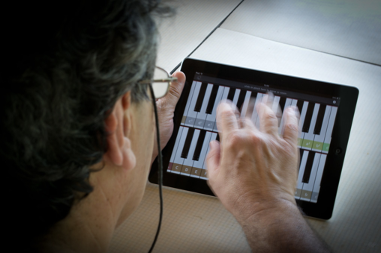

It is important to remember that CI users differ in their accuracy and appreciation of music.
-
Individual factors such as motivation and attitudes towards music training can affect how beneficial training is.
-
The amount of formal music training (e.g. music lessons, singing in choir) prior to implantation can also have an impact.
-
CI users also differ in the role of music in their lives, and their goals for improving music.
-
Some CI users want to recognize familiar songs or musical instruments.
-
Some want to enjoy the sound of music more. Others may want to enjoy singing or playing instruments.
-
CI users also different in the style of music they enjoy.
-
-
Therefore, it is important to choose music training that is suited towards individual background, needs, and wishes.
Q: What is commonly included in music training?
A: The most common types of training that have been researched so far studied include:
-
Perceptual accuracy for pitch, rhythm, and timbre.
-
Appreciation (appraisal) of music listening.
Because there are many kinds of music, and music can be very complex, training can be broken down into many different smaller musical perception and appraisal tasks. Rhythm is usually well-perceived by CI users (similar perception as normal hearing adults). Therefore, training is more likely to focus more on pitch and timbre.
Practical Music Training Recommendations
Q. Can I work on improving music listening without participating in a special research study?
A. Yes. The information below offers some practical tips for self-directed music listening practice.
Before you begin, remember that music will not become the same as it did prior to your hearing loss. That can be disappointing, of course. But many people can improve music perception over time with training. Here are practical recommendations for music listening and participation:
-
Establish realistic expectations.
-
Do not expect your experience to be the same as what you read on blogs and website of other CI users.
-
There are many things that can affect what kind of training works best, and how quickly you improve.
-
Age of implantation (i.e. as a child or adult) may impact expectations regarding sound quality of music.
-
Amount of formal musical training can influence expectations and motivation to improve music listening.
-
-
-
Some musical experiences may be more enjoyable than others. You can discover aspects of music that are pleasant to you through trial and error.
-
-
Music perception can improve with practice, but change will likely take a lot of repetition over time.
-
Do not expect improvement overnight.
-
As is true for learning any skills, most changes take place a little bit at a time and over weeks or months.
-
-
Short listening sessions over the course of several days can result in more progress than fewer longer practice sessions.
-
When you practice listening, choose times of day you feel most rested and alert. That helps your brain to learn more easily.
-
-
Practice music listening in a good listening environment.
-
Practice in spaces that have good acoustics—quiet and not much echo (reverberation).
-
Click here for more information about how the environment affects music listening.
-
-
Begin training by focusing on the parts or types of music that sound the best through the CI.
-
Rhythm is the easiest part of music to hear through a CI. Start by listening to music with a strong, simple beat.
-
Song lyrics can help people to make sense of music.
-
Click here for more information about how different musical sounds affect listening enjoyment.
-
-
Use your other senses while listening to music.
-
Use visual cues such as watching the musician, reading the notes, or song lyrics (e.g., closed captioning of music videos).
-
When possible, feel the beat of the music through the speaker while you listen to the sound.
-
-
Use trial and error.
-
Experiment with different songs, listening environments, and situations to find what is most accessible and enjoyable for you.
-
Try different styles of music.
-
Try different instruments or voices.
-
Experiment with solo music, small ensembles, and work your way up to larger bands or orchestras.
-
-
-
Spend time listening to previously familiar music.
-
You can use your memory of the music and past knowledge to help make sense of the sound.
-
-
Choose music that is of particular importance and meaning to you.
-
Listening to music that is important to you can help you to keep trying, even when things don't improve right away.
-
This can help you apply your practice to everyday life experiences.
-
This might include simple familiar songs you are likely to hear in everyday life (e.g. Happy Birthday, the Star-Spangled Banner, etc.).
-
-
-
Listen to music played by individual singers or instrument players to improve timbre recognition.
-
Listen to solo experts for commonly heard musical instruments (e.g. piano, flute, clarinet, etc.).
-
-
For more rapid success in playing instruments, select instruments that do not require ongoing tuning and that focus on rhythm.
-
Playing percussive instruments may be beneficial (e.g. drums, xylophones, piano, etc.)
-
-
Click here for more information for musicians who use cochlear implants.
(Gfeller, 2012; Gfeller, 2001)
Q: Are there computer- or web-based music training currently available?
A: Yes. Angel Sound (http://angelsound.tigerspeech.com/) is a free interactive listening rehabilitation and functional hearing test program available for adult and teen CI recipients. It is a self-based rehabilitation program that allows users to practice and work on their listening skills at home. It includes basic to advanced training modules.
Also, check the website of your CI manufacturer to see if they offer free or inexpensive music training applications. However, keep in mind that not all available training applications are supported by scientific evidence, so be a good skeptic.
Click here to view Decision Trees, which illustrate step-by-step problem solving for planning for music listening at home.
Music Training Recommendations for Professional or Avocational Musicians
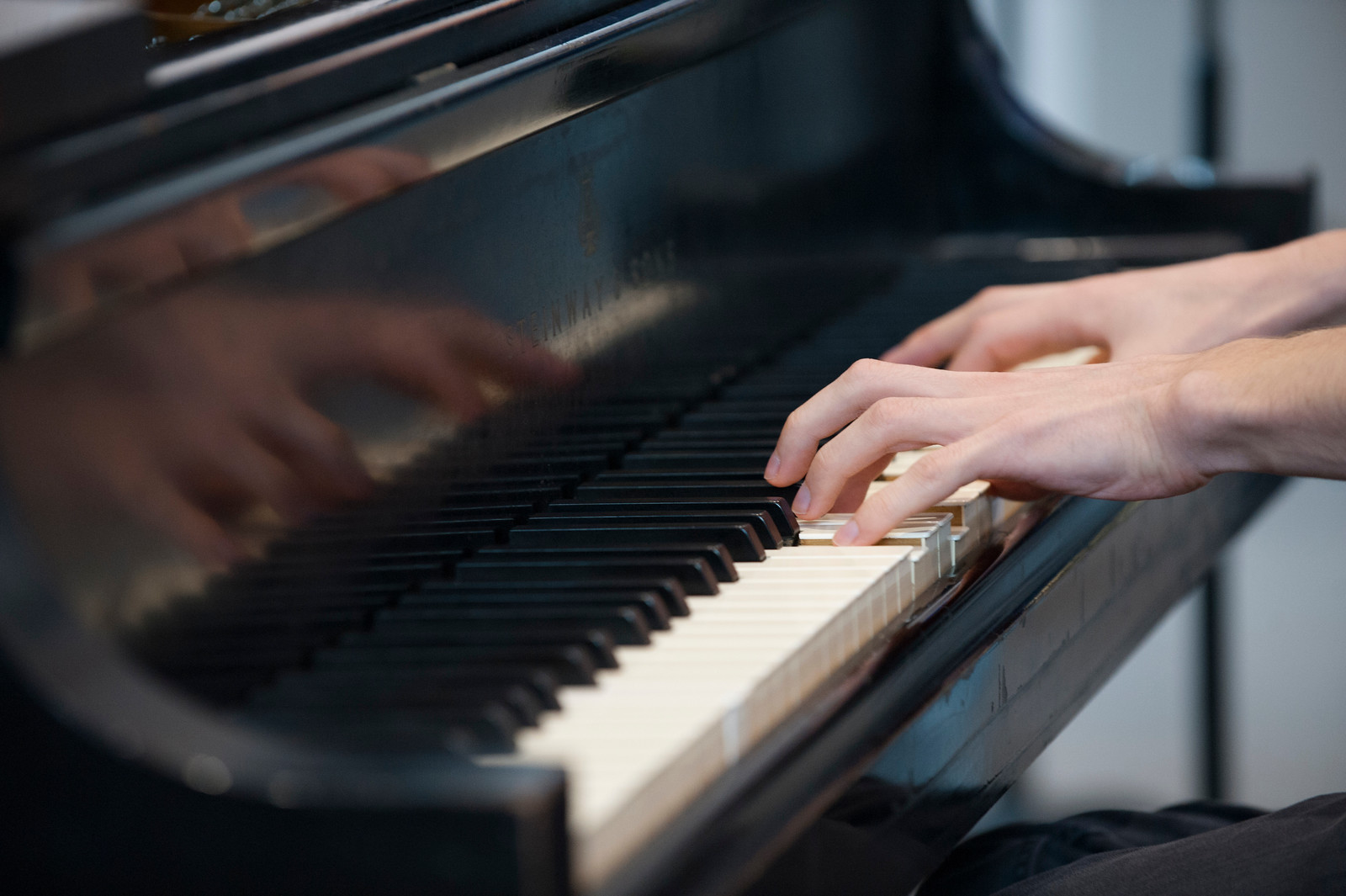
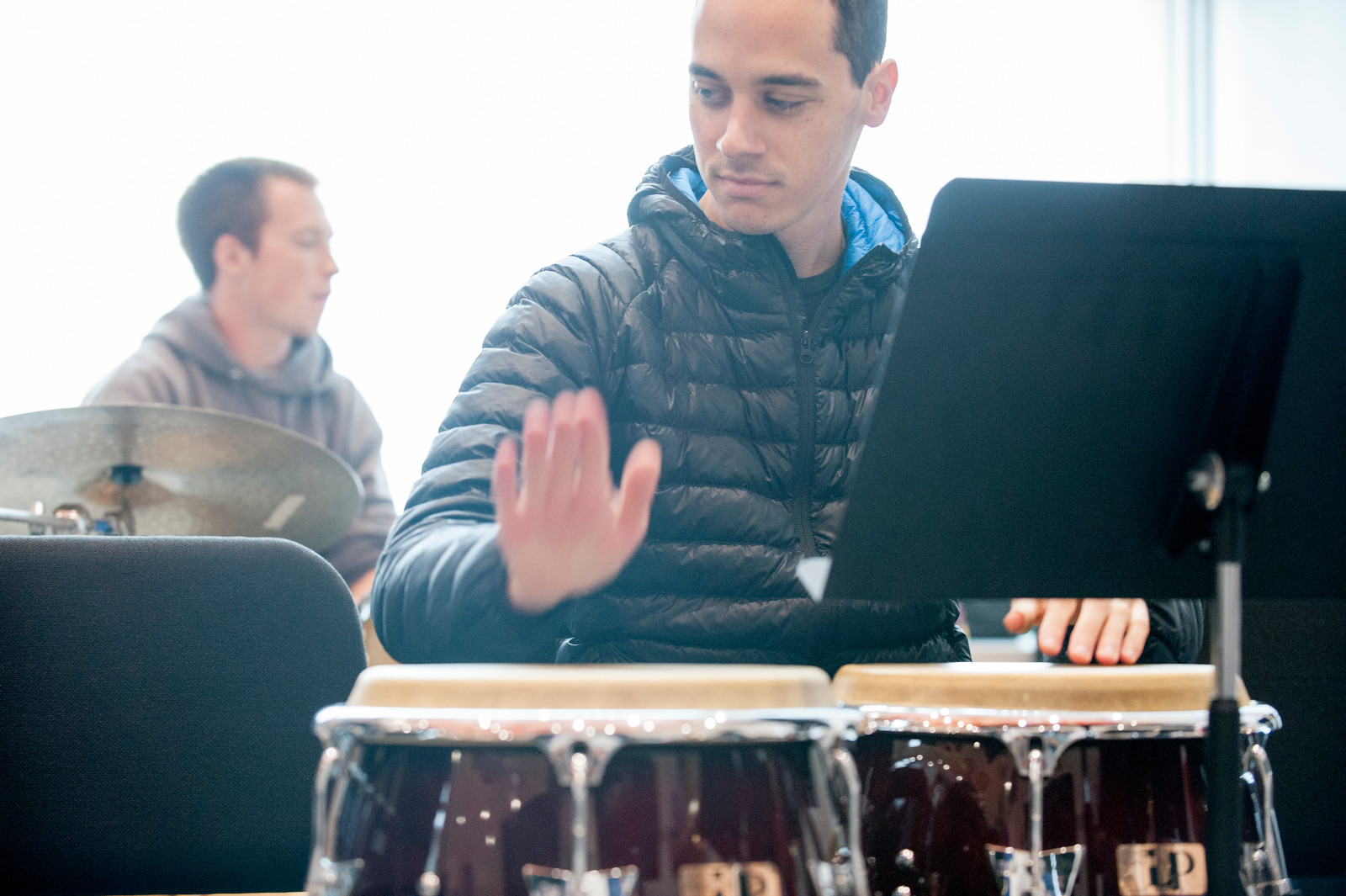

Musicians may have specific goals and higher motivation than the typical CI user to improve music experiences. They may be more willing to put in considerable time and effort to improve music-making as well as music listening.
Below are strategies from CI users who have achieved or re-established high levels of musicianship after implantation:
-
Use all your senses: this involves visual, vibrotactile, muscle memory, body proprioception, and movement to perceive the music.
-
Use top-down processing: use your internal memory to help your brain process different musical sounds, such as pitch, recall of instrument sound, familiar songs, and intervals.
-
Select accessible musical elements: start with sounds that are more easily perceived by your CI, such as rhythm.
-
Be mindful of focus and energy: listening to music can take a lot of focus and energy.
-
Choose times of the day that you feel most focused and energized for listening practice.
-
-
Try music theory exercises: use instruments with fixed pitches (e.g. piano) to practice intervals. Other exercises include pitch matching, listening to subtle pitches, and practicing pitch sequences.
-
Listen with careful attention: listen to music and repeat; on each repeat, focus on different elements or layers of the song.
-
Practice music-making: practice and/or rehearse many times and build music perception skills overtime.
-
Consider taking music lessons from a teacher who is understanding about your needs and goals: take music lessons as a means of motivation and support; lessons can also enhance knowledge of specific exercises you can use.
-
Learn from other CI users: receive input from other CI users through support groups, online, or in conferences.
-
Try singing: singing in tune to an external pitch is one of the most challenging musical skills for CI users. But practicing singing can help with intonation and internalizing pitch.
-
Try new technology: use trial and error to find your preferred method for music listening (e.g. headphones, Bluetooth) and optimal CI program/settings. Tuning apps may also be helpful for assisting with pitch perception.
-
Seek out new information: going to conferences can be a great way to learn new information and strategies.
Click here for more information about singing or playing instruments with a cochlear implant.
Suggested reading:
This article shares input from a unique group of CI users who are high-level musicians, and their strategies for improving music enjoyment and music-making. These people spend many hours most days to improve their music playing and listening.
Click on the title to access the article: Gfeller, K., Mallalieu, R. M., Mansouri, AL., McCormick, G., O’Connell, R. B., Spinowitz, J., & Turner, B. G. (2019). Practices and attitudes that enhance music engagement of adult cochlear implant users. Front. Neurosci, 13, 1-11.
References
Gfeller, K. (2001). Aural rehabilitation of music listening for adult cochlear implant recipients: Addressing learner characteristics. Music Therapy Perspectives, 19(2), 88–95. https://doi.org/10.1093/mtp/19.2.88
Gfeller, Kate. (2012). Music perception of cochlear implant recipients and implications for counseling and (Re)habilitation. Perspectives on Hearing and Hearing Disorders Research and Diagnostics, 16(2), 64. https://doi.org/10.1044/hhd16.2.64
Gfeller, Kate, Guthe, E., Driscoll, V., & Brown, C. J. (2015). A preliminary report of music-based training for adult cochlear implant users: Rationales and development. Cochlear Implants International, 16(sup3), S22–S31. https://doi.org/10.1179/1467010015Z.000000000269
Looi, V., Gfeller, K., & Driscoll, V. (2012). Music appreciation and training for cochlear implant recipients: A review. Seminars in Hearing, 33(04), 307–334. https://doi.org/10.1055/s-0032-1329222
Patel, A. D. (2011). Why would musical training benefit the neural encoding of speech? The opera hypothesis. Frontiers in Psychology, 2. https://doi.org/10.3389/fpsyg.2011.00142
Click here to review references used in preparation of this website.
1. All images on this website are used under Creative Commons or other licenses or have been created by the website developers.
2. Click here to access the sources of images on this page.
